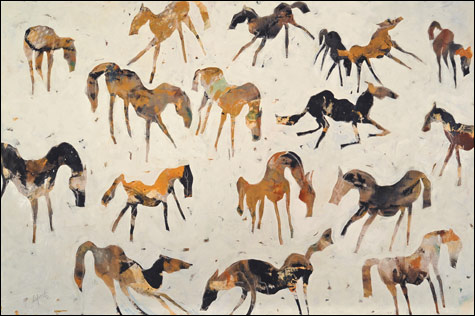
"CRAZY HORSE" Oil on canvas, 36 x 54 inches, by Andre LaPorte. |
Septuagenarian Andre LaPorte may be a veteran artist but, relative to his long career, he is a new painter. His solo exhibition at Greenhut | "EQUUS IN THE GRANGE" paintings by Andre LaPorte | at Greenhut Galleries, 146 Middle St, Portland | through March 28 | artist talk March 14 @ 1:30 pm | Free | 207.772.2693 |
Galleries evinces the masterful ease of composition and line inherited from his New York City years, spent cutting his teeth as an illustrator for heavyweight fashion-industry companies. These current paintings, however, reveal a still-youthful exploration of style that leaves the body of work with a kind of energy and promise usually reserved for an up and coming artist. LaPorte's been around the block, but in his exploration of architectural forms and pastoral themes, he's by no means stuck in his ways.LaPorte shares a tandem exploration of horses and the geometric relations of architecture for the show, titled "Equus in the Grange." "Crazy Horse" involves a reductive approach to create a dramatic study in movement. Silhouettes of horses bend and curve, interacting with one another in a vague dreamlike color-field. The artist creates these loose forms by building a thick layer of white over a complex underpainting filled with dark dripping colors. One last layer of gold creates highlights in the musculature, solidifying the creatures' shimmering insubstantiality. Form is implied with graceful economy, most notably in the dancing legs and curving necks of the horses. In "Grazing," the spindly legs echo the drips of the underpainting.

A variation on this approach feels less effective when LaPorte chooses to create the horses through an additive application of the paint, as with "Horse #4" and "Horse #105." We lose the artist's ingenious formal play of compositional ground, and the silhouette device begins to feel more like design or iconography. In the context of the show, these pieces are welcome evidence of a transparent sharing of artistic twists and turns. The drawbacks and successes of "Equus in the Grange" are rooted in the same exploratory soil.
The range of stylistic variation is even more evident in the architectural works. "Grange #38" and "City #205" feature an overlay of vibrant oil pastel in a free gesture reminiscent of '80s graphic design or the quick coloring-in of a fashion-industry sketch. Meanwhile, the palette and thin line renderings of "City #210" jump back a few more decades to feel positively Art Deco. "#210" is an example of LaPorte as compositional master. Each element either hangs off the canvas with its own weight or is delicately balanced on another form. Every line is not quite straight and each arch not quite centered, but taken together, the piece sings.
Imperfect harmony is also evident in "Grange #38" where the loosely peppered barn-like forms inhabit a rich black ground. Earthen tones are hewn into the canvas while sandblasted turquoise highlights form topographical islands within the bounds of the buildings. Though the sander and brush are applied intentionally, the results require a creative tolerance for random occurrence on the part of the artist and reward the viewer's eyes by way of a depth of texture.
"East Prom West Prom" shares a triumphant place with "Grange #38" at the head of the class. With LaPorte, there is always balance, and in the case of this promenade portrait, there is a dialectical conflict here between an implied stasis (the gestural lines of architecture) and implied motion (the turbulent brushstrokes and unstoppable drips). As burnt colors swirl as windy sky and running colors form geological canyons in the canvas, the viewer is provided with the faint pastels of sloping roofs and doorways. There is no weight to the structures, more of a force field of gestural line containing the emotional windswept underpainting.
Here and in "Grange #38," the building up of media and its consequent removal is fundamentally sculptural — not just an exercise in composition or color, but a physical delivery of a pictorial state. It is in this milieu that LaPorte, moving fully beyond the habits of illustration, achieves a mode of pure painting.
Ian Paige can be reached at ianpaige@gmail.com.